- You have participated in several overseas tours of Bunraku, and you have just returned from a performance tour in France in March (2008). How do you introduce the interesting aspects and appeal of Bunraku to foreign audiences?
-
I don’t make any special considerations just because the audience is a foreign one. There are still many people in Japan as well who have never seen Bunraku. And, those who are seeing Bunraku for the first time often ask me what they should look and listen for. But it is difficult for us as performers to say ’This is what you should watch for. This is what to listen for.’ The repertoire is large and there are
jidaimono
plays based on historically events and
sewamono
plays based on the lives of the common people, with dozens of plays in both of these categories and each play having its own unique appeal and highlights. So, it is difficult to generalize about what an audience should watch for.
Bunraku is a unique and truly rare form of theater conceived by Japanese some 300 years ago. It is a form in which a story is played out by a three-part ensemble of the puppet manipulated by three puppeteers, the tayu narrator and the shamisen musical accompaniment. It might be and exaggeration to say that the Bunraku puppet operated by three puppeteers exceeds the expressiveness of a human actor, but it definitely is capable of expressive actions not possible by a human, and for this reason the actions of the doll probably attract most of the audience’s attention at first. That is all and well, but in fact Bunraku is actually a three-part performance that is based on a fine coordination and harmonization by the tayu, the shamisen and the puppets. In addition to the puppets there is also rich appeal and artistry in the performance of the tayu and the shamisen which enable Bunraku to be seen from different aspects, which I believe enriches its interest greatly.
Being able to understand the Japanese joruri narrative and dialogue of the play would naturally give the foreign audience more insights into the thoughts, customs and emotions of the Japanese people and bring more appreciation and enjoyment to the foreign audience, but even with the use of [projected] subtitles or commentary it is difficult to offer foreign audiences a full understanding of the contents of the joruri as they watch the performance. The language that the plays were written in back in the Edo Period is also difficult for younger Japanese today to understand, which is why Japanese subtitles are used when we give performances at the National Theaters in Japan. We hear people say that they were able to understand the play well because of the subtitles, but I wonder if it is really true. Thanks to the subtitles they are able to understand the story and what the tayu is saying, but I don’t think that is really a true understanding of the performance as a whole. I would rather have the audience watching the performance carefully as a whole rather than reading subtitles. - Is it correct to assume that Bunraku is the world’s only puppet theater where a single puppet is manipulated by three puppeteers?
-
As far as I know there were no other 3-man puppets in the past. But today there appear to be many forms of puppetry. Until now I have gone to France twice to teach the techniques of 3-man puppetry and the people I have taught are now doing 3-person, 4-person and 5-person puppetry. There are now several places in the world where Bunraku type puppetry is being performed.
The teaching I have done until now was 3-week summer seminars at the national puppetry institute of the Union Internationale de la Marionnette (UNIMA) in Charleville-Mézières, France. The courses were attended not only by puppeteers but also by directors, actors, ballet dancers and people from a number of different genres. I wanted to stress the fact that manipulating the feet is the fundamental base of Bunraku puppetry, so I had them make puppet feet from wood. I got the idea of having them experience making the feet because we didn’t have enough feet to supply the dozens of participants in the seminar, and you can’t teach without having actually feet for them all to practice with. The wood was supplied locally but the nikawa glue and the Chinese White pigment that are mixed to paint the feet white were brought from Japan.
I’m sure that the participants were wondering why they were being made to cut the wood into blocks and carve it into feet. But I was not there to simply teach them to manipulate the 3-man puppet. I was there to teach them how difficult it is to manipulate the Bunraku puppet well and that it is not something that they should try to imitate lightly (laughs). In Bunraku puppetry the omozukai [head puppeteer], hidarizukai [left hand puppeteer] and ashizukai [foot puppeteer] have to be able to move as one and communicate their intentions without words. This is an art that can only be learned by the body through long period of practice. It is not something that can be studied for three or four weeks and think you have mastered. So, it is fine if they can fine something useful, some reference for what they do, in our art, but I wanted to show them that it is a very difficult art that takes a long time to learn. I wanted them to experience this physically by making the feet. And the result was that they said ‘I see.’ (Laughs) They did understand.
In this way, I had them practice manipulating the feet, but for the taller foreign participants, bending down to manipulate the feet for extended periods is difficult. Still there was one young French participant in his twenties who was shorter and did it so well that I would have liked to bring him back to Japan. In those three weeks he nearly mastered the foot movement, it was wonderful to see. I should have asked him to come to Japan. He might been the first foreign apprentice in Bunraku (laughs). - Traditionally, it is said that the training in the art of Bunraku puppetry takes ten years to master the feet and ten years to master the left hand before moving on to main puppeteer ( omozukai ). Is that another way of saying that manipulating the feet is the fundamental upon which Bunraku puppetry is based?
-
That’s correct. I believe that one of the biggest merits gained when Bunraku adopted the 3-man puppet manipulation we now use is that it gave the puppet foot movement. According to records, 3-man manipulation was first adopted in 1734 at the Takemoto-za theater in the Dotonbori district of Osaka, when they performed
Ashiya doman ouchi kagami
. I am very impressed when I think of the people who came up with this idea 270 years ago and made it work. There is a record that a 3-man puppet had been used at a small theater called Geki-za theater in Edo (present Tokyo) about 40 years before that, at the end of the 17th century. But it was completely different, in that one puppeteer moved the head while a second manipulated both arms and the third manipulated the feet. It must have been very difficult to manipulate that way. Because, even with our present-day style, it is very difficult for the omozukai [head and right hand puppeteer] and the ashizukai [feet puppeteer] to coordinate their movements. Although there are few records for the intervening 40 years after that first attempt, the puppeteers must have tried numerous variations before arriving at the present style that came into use at the Takemoto-za theater in 1734. And after that, there was a rapid shift to 3-man style puppetry throughout Japan.
The difficult thing about 3-man puppetry is that each of the three people manipulating the puppet bares an equal share in the task. Of course, the omozukai is the main puppeteer, but it is not a case where the omozukai is doing 70% or 80% of the job. In the case of a female-role puppet, the ashizukai does half the work. Since the female puppet has no feet, the ashizukai has to move the hem of the kimono in a way that makes it look as if it has legs and feet. That is why it can be said that the ashizukai has half of the responsibility for the movement of the puppet. In certain scenes and with certain choreography the hidarizukai [left hand puppeteer] also plays a very important role, and of course there are many places where the omozukai is most important. So, all three puppeteers have to be giving 100% to 120% to successfully manipulate the puppet.
I think it is safe to say that at any time, the ashizukai is doing half of the work involved. If the ashizukai suddenly lets go of the feet, there is no omozukai, no matter how skilled he may be, who can hold the puppet and continue to manipulate it. So, the real meaning of “ten years to learn the feet” doesn’t mean that it takes ten years to finally graduate from the lowest job. Rather it means that after ten years you have reached the point where you have a good grasp of what is required in the overall manipulation of the puppet that you can manipulate the feet well and at this point half of your training is complete. That is why we are told constantly when we are young to do the feet as much as possible.
Still, while you are being told to do the feet constantly as a young puppeteer, you don’t really understand how important the role of the ashizukai is. That was true in my case, too. And that is the stage where many people feel like quitting. You start to wonder why you have to do this same job day after day. Day in and day out you are bent down in a difficult kneeling position and no one is seeing you there on stage because you are wearing the black head-cloth that hides your face. The names of the ashizukai aren’t even listed in the program. But if you can stick it out and get beyond the ashizukai stage, then suddenly everything is OK. - Does that mean that once you have learned the basics of the ashizukai you can naturally move on to the hidarizuai and omozukai with no problem?
- The ashizukai always keeps part of his right forearm on he hip if the omozukai to receive signals about the next movements of the puppet. This is called koshiatari (hip contact), and it is the communication method that tells the ashizukai when the next move is coming. Once the ashizukai learns to read these signals he can concentrate on coordinating the puppet’s movements. Then it is a question of how quickly he can learn the puppet’s role in a given scene. He has to become one with the movement of the puppet’s feet, and that is not an easy thing to do.
- The way men and women walk and the way a samurai and a commoner walk, or the way an old person and a child walk, certainly there is a variety of forms an ashizukai must learn.
-
That is true. And it is not just the ashizukai. The really difficult part is going beyond the level of technique to the level of character development. That is why it takes ten to 15 years of training. The most important thing you must accomplish when you become an omozukai is the ability to become one with the puppet and one with its character in the play.
The puppeteer in Bunraku is both an actor who acts out the role of his puppet’s character and a technician who manipulates the puppet. If one of these two capacities is strong and the other weak, the performance will be lacking in expression. The feeling you are trying to put into the role will not be communicated to the audience. So, when you are learning the feet you are also thinking about the feelings that each of the famous omozukai you work with are putting into the roles acted out with the of the different puppets in the different plays. And when you feel that intent of the omozukai you must try to become one with it and move the feet in harmony with it. An ashizukai who can only do nice, graceful movements of feet will actually be making it harder on the omozukai. The omozukai has expectation of the kind of movement he wants from the ashizuka based on the emotion he is trying to put into the puppet’s character and actions. So, no matter how graceful the foot movement may look, if it isn’t in sync with the emotive intent of the omozukai it only makes things difficult for him. I made that mistake when I was an ashizukai too. When I realized that, it was the one time that really felt I wanted to quit puppetry.
My master is Minosuke Yoshida, and when I used to make that mistake it would put him in a bad mood. Master Minosuke is the type who usually doesn’t say a thing, and I believe that is the way all the old masters used to be. They don’t tell you what you are doing wrong. They just let you see that they are in a bad mood. On my part, I had been doing the feet for years and I had some confidence. And since I was at the point where I was doing the feet of the main character (puppet) of the play, it sort of went to my head and I would get in the mood where I wanted to show off what I could do with the feet. My movements looked good. No matter what angle the puppet was photographed from the position looked good, and my timing with the shamisen was good too. Part of the job of the ashizukai is what is known as the ashibyoshi (foot beat). The ashizukai stamps his feet loudly to create the sound of the puppet’s footsteps. And, I was able to keep the proper beat. But still the master was in a bad mood every day. I hadn’t figured out yet what I was doing wrong. - Couldn’t you just ask the master what you were doing wrong?
-
Even if I did ask, he would never answer. When I did ask, all he would say is, “How many years have you been doing this [and still don’t know].” You have to think and figure it out by yourself. When I would ask some of my older colleagues and have them watch me, all they would say is “I don’t see anything strange.” They didn’t know either. That made me even more lost. The answer was that—as I said earlier—my movements as an ashizukai were not the movements of the character that master Minosuke was trying to give the puppet while acting out its role. And what he was criticizing me of not knowing after being an ashizukai for so many years was not having that very difficult, very high-level sensitivity to be able to move the feet in accordance with the feeling that master Minosuke was trying to give the puppet in each particular moment in each particular scene in each play.
This was something that I came to realize gradually. On our tours there would be times when we would drink with master Minosuke after the performances. He would start telling the same old stories, but gradually I realized that I had to listen carefully each time and not dismiss it as just the same old story I had heard five times before. Because I realized that he was saying things through those stories that he would never say directly to us. I realized that when words like, “The hidarizukai and the ashizukai both have to approach the role the same feeling [that the omozukai is putting into the puppet’s performance],” I realized that he might be speaking to me indirectly. So I would think carefully about what he was saying. The master would never say anything directly to me about how I was handling the feet. So I had to listen to his stories, think about them and try to apply them to my state at the time. That is how I finally figured out what I was doing wrong and worked my way out of that state of confusion I was in.
In short, the ashizukai and hidarizukai also have to achieve the level where they are both actors and technicians. But it is particularly the omozukai who has to find the heart of each role the puppets play. That is exactly what I am struggling with now, and it is the important task that I want to devote myself to in the in latter half of my 50s. As for the technical side, I have been doing it for more than 40 years now, so it would sound stupid if I said I still lacked confidence in that area. - Even though you may go through the same training process, the different puppeteers still seem to develop different styles and individuality. We also see a difference in where the puppeteers look when they are manipulating the puppet. Some puppeteers move their eyes in the same line of sight as the puppet. Can you tell us where a puppeteer looks when handling the puppet?
-
The basic rule is that the omozukai should not change his facial expression and should move [his head] as little as possible when performing. The omozukai is the only one of the three puppeteers whose face is exposed, and for that reason we have the expression
dezukai
(exposed puppeteer) since the Edo Period. If the role is one of a beautiful princess and the omozukai behind her (the puppet) is a man with a darker-skinned face, you don’t want the audience’s eyes shifting to his face. So, the omozukai has to learn the technique for getting the audience to focus on the puppet’s movements and expressions rather than his own. The first things you can do toward that aim are to not move much and not change your facial expression. But as his skills advance people say things like the omozukai seems to disappear or becomes invisible. But it takes a long time to reach that level.
They say that it is the movement of the eyes of the omozukai that the audience notices most. I have an older sister who is an actress and she used to tell me often that I should focus on one point. There are no rules in Bunraku about where the omozukai should look, but in my case I usually focus on the back of the puppet’s head or the area from the back up to the head. However there are also some omozukai who look in a completely different direction from the puppet.
The thing that you definitely must avoid is allowing the puppeteer’s body to move before the puppet moves. If the puppet is going to look to the left, you don’t want to have the puppeteer turn to the left first and then turn the puppet to the left in a 1-2 movement. The puppeteer’s body will move to some degree with the puppet, but you can’t let the puppeteer’s movement stand out more than the puppet’s movement. It is often said that in order to show the puppet with beauty of movement you have to first do annihilate your own body. You can’t let yourself act along with the puppet. The acting that is in your heart as to be transferred to the puppet through your left hand and then projected out to the audience through the puppet alone. This is a very difficult thing to achieve. It is a constant and trying struggle. - Despite the trials and tribulations you press on as a puppeteer. What was the appeal of Bunraku that made you decide to make it your career?
-
It was in May of 1965, when I was in my second year of middle school, that I was first really attracted to Bunraku. It was a time when there were far fewer puppeteers than there are now. There were only 27 at that time. Since it takes three puppeteers to manipulate one puppet, there was always a lack of hands when performances were being held. For one performance my father (Kanjuro Kiritake II) told me to come help out. Since my father was a Bunraku-za puppeteer, I had often gone with my parents to see Bunraku when I was young. I had often gone to the dressing room and the theater lobby and the audience seats, and I had thought of those places as where my father worked. But it wasn’t until that experience of wearing the black clothes and head-cloth and helping out backstage that I really saw where my father worked and what an amazing world it was.
And what I thought was the most impressive of all was the job of the ashizukai. Me and the other helpers that had been gathered for that play had to stay hidden behind the balustrade in the wings and hand props and things to the actors or line up the stage clogs that the omozukai wears on stage. As I sat crouched there in the wings, the thing I could see best of all right in front of my eyes was the feet of the puppets. I was amazed to see how they looked and moved just like the feet of a real person. Seeing that, I got the idea that I would like to learn to do that. I was a child who liked making models and drawing pictures and I was also interested in the mechanisms that made things like mechanical dolls work. So, everything backstage at the Bunraku theater fascinated me, from the mechanisms in the puppet’s head [for eye, eyebrow and mouth movement] and the sets and props to the way the puppet head dresser tied up the hair. When I delivered a head to the head dresser, I was supposed to return immediately to the stage, but I would end up standing there watching in fascination as she dressed up the hair. That’s the kind of child I was. During the year or so that I was helping out as a stage hand, I became more and more interested in the movements of the puppets, and it was during my third year in middle school that I decided to become a puppeteer. It was my father who decided that Minosuke would be the master I apprenticed under. - So, that fascination you felt back then has connected to your career today?
- In fact it got more and more interesting all the time. I feel that now I am at the most interesting stage of all since becoming a puppeteer. Since about two years ago, I’ve come to a stage where I feel that the puppet is moving naturally by itself. In the past I had to try so hard to make it move as I wanted. Perhaps some of it comes from being more used to it, but today I don’t work up a sweat even when I an manipulating the biggest and heaviest of the puppets. For this year’s May performances in Osaka, one of my senior puppeteers, Bungo Yoshida, was sick and I had to fill in on one of his roles besides the two I was doing. One of the roles was Watonai of the play Kokusenya gassen , which is the largest puppet in the Bunraku repertoire. Another was Tokichi of Kinkakuji , the fourth chapter of the Gion sairei sinkoki , which is the first character I have played with a puppet wearing armor. The third role was Magoemon of the play “Ninokuchimura no dan” chapter of Keisei koibikyaku , which is a difficult role of an old man. All three of these were first-time roles for me and I was worried whether or not my strength and stamina would hold out. But I ended up enjoying it all very much. Since all of these were new roles for me, there was a tremendous amount of pressure, but I found myself thoroughly enjoying going out on stage with the puppets each time. In the 42 years since I became a Bunraku apprentice I have never enjoyed it more than this.
- I think that enjoyment shows in your performances. The puppets you handle seem to carry a big aura on stage. The Miuranosuke you performed in your current production of Kamakura Sandaiki truly comes across as a beautiful and gallant young warrior.
- This Miuranosuke was another first attempt for me, but I think that I may have had a good hold on the role and the character. I had a clear image in my mind of the kind of person Miuranosuke was. When he comes back from the war out of concern for his sick mother, calling out, “Mom, Mom,” and is told by her, “Any young warrior who would show his back to the enemy and leave the battlefield to come home is no son of mine,” he tells her, “I will go back to battle,” but still lingers on by her side.
- A “mother complex” perhaps. Your performance gave the feeling of his youthfulness and somewhat spoiled nature.
- That is something that can be done with a Bunraku puppet. With live actors, in something like the role of a young princess being played by a somewhat older actress, no matter how gorgeous her costume may be, you are going to be bothered by the face. But the puppets never age and that gives us an advantage. The puppeteer behind the puppet may be 70 or 80, but the puppet is still the same young princess. The only problem is whether the puppeteer can continue to find the feelings of a young girl. My master Minosuke is 75 this year, but in April he performed the role of the 14-year-old maiden Ohan in Katsuragawa renrino shigarami , and it was undeniably a convincing 14-year old. For a 75-year-old to perform a 14-year-old role that really looks 14 is a testament to the artistry of the master and also a testament to the amazing art of Bunraku. The puppeteer has to be able to find a variety of feelings for the many roles of the Bunraku repertoire and be able to go out on the stage with the feeling of a young man or a young woman and find the essence of the role. As I said earlier, technique alone is not enough to achieve the kind of expression necessary in Bunraku.
- A year has past since Bunraku puppetry lost one of its greatest pillars in the late Tamao Yoshida, who was a Living National Treasure in Japan. Then, this January another great figure passed away in Bungo Yoshida. Now you are taking on many of the important roles, not only on the stage, but in the training of younger performers, and in this capacity you are truly a leader of today’s Bunraku world.
- It all came so suddenly. Our older generation masters passing away one after another. It was completely unexpected. In terms of generation, Kazuo Yoshida, Tamame Yoshida and myself are the second generation after the late master Tamao. My master Minosuke and master Bunjaku are the first generation after master Tamao. Then there is the late Bungo and Tamako Yoshida, Iccho Kiritake and Monju Kiritake and then we were the generation after them. So, the sudden shift in the Bunraku world came unexpectedly and I asked myself what was going to happen. We have a serious lack of puppeteers now who can do the main tachiyaku male roles. This is where my generation has to try to step in and fill the gap. In September, Seinosuke Yoshida of the generation after me will inherit one of the master’s names. He will be reviving the Seijuro Toyomatsu name. Seinosuke is capable of doing both onnagata female roles and tachiyaku male roles. I look forward to working with their generation to build the future of Bunraku, but I am also worried because the tayu masters are also quite along in years.
- To become a tayu with the vocal virtuosity to be able to perform the voices of characters young and old, male and female, and even the voice of a “little runny-nosed boy” well into his 60s, is said to take long years of training. Because it takes a long time to pass on such a traditional art form.
- This is something that master Sumitayu Takemoto is also worried about, but at 84 he is still the most energetic tayu of them all. And among the puppeteers, my master Minosuke at 75 is the most energetic. So as long as they are healthy and energetic, we have to learn as much as we can from them and try to absorb it all. We have to be as aggressive as we can about learning everything we can from them and never let ourselves think that we have learned all we can from them. And there is still a lot more. After 40 years of learning from my master it is easy to think that I have learned all of his skills, but then I find something more that I didn’t know about. Since the master himself is never satisfied with his own art and always trying to perfect it, there is no way that I can ever catch up. As long as he is alive, I will never catch up. It is an amazing thing, my master’s art.
- Besides pursuing and refining your own art, you are also teaching at schools, conducting workshops and other efforts to build the Bunraku audience, such as giving demonstrations and explanations at stations of the Tokyo Metro subway system.
- There are still many, many people in Japan—let alone overseas—who have never seen a Bunraku performance. For that reason, I want to help us do a more complete job of promoting our art, even at the grassroots level. Even our regional tours in Japan go only to the major cities. In the past Bunraku performers went much deeper into the countryside to smaller town, and that is something I would like to do too. Although it is a program that includes only one elementary school at this point, the Osaka Municipal Kozu Elementary School, I go there to teach their 6th graders. For seven years now we have been going to teach special classes in tayu, shamisen and puppetry. Although we didn’t begin the program with the intent of training the next generation of Bunraku performers, we hear that one of the 6th graders from the first classes seven years ago has now entered apprenticeship under Sakitayu Toyotake with the intent of becoming a tayu. There was another student who asked me if he could become my apprentice. I told him to begin by building his strength. I heard later that he was doing pushups every day and when I saw him again as a middle schooler he looked healthy and focused. I was looking forward to the day when he would be being training, but I was sad to learn that he became ill and passed away recently.
- You have started an NPO called the Ningyo Jorori Bunraku-za.
- It is in its 5th year now. The Bunraku tayu, shamisen players and puppeteers all got together to create this NPO that was officially recognized by the Osaka government. Before that there was a mutual aid society but there was no organization that brought us all together as one. The performances we give at the request of nursery schools and homes for the elderly and programs like the Kozu Elementary School classes I just mentioned are all done as programs of our NPO. For the NPO I serve as the chairman in charge of copyrights. Until then there had been no copyright management for photographs of Bunraku performances, so we created one. When you see a photograph of a Bunraku performance, all that will probably be seen is the omozukai and the puppet, but in order for that photograph to be taken there must also be an ashizukai and hidarizukai working there too. If it is a video the accompaniment will also be there. When I have time I check the data and go to the people who appear in the photos and videos and get their permission for its use. I’m finally getting used to it but this copyright verification is quite a job.
- It sounds like you are laying the foundations for the future of Bunraku. Can you tell us something about your vision of that future?
- I can’t make any grand statements, but I can say that I want to help pass the Bunraku tradition on to the next generation with its forms intact. Noh has continued for 600 years with its forms and tradition intact. They say the reason is that they have stuck to the tradition of learning to do things as their predecessors and teachers did. Bunraku is the same. Normally, a tradition will break down little by little over time. If you set out to break tradition intentionally, it will be break down within a year, or even half a year. That is why I want to help pass this long-held tradition on to the next generation without losing any of the elements that have been handed down for hundreds of years. I also believe that this is important from the standpoint of maintaining and growing our audience. Right now I feel assured because our Tokyo performances are attracting a large audience, but you never know when that trend will change and suddenly people aren’t coming to see Bunraku anymore. We have to maintain the high level of our art. We can never let it reach the point where people are saying, “I was invited to go see it but I wasn’t impressed.”
- You have spoken about not allowing the tradition to break down, but there have also been new experiments lately such as performing newly written plays and using different kinds of music from the traditional joruri , such as gospel and [Western] classical music. It seems there is a thin line between experimentation and breaking down traditions.
-
It is a thin line. But if you maintain the traditions and are trained and practice to the degree that that you can perform the traditional repertoire at any time, then I believe it is all right to try other things when you want to. Even as I preach that we must maintain the tradition, I am the one who is experimenting with new things more than anyone else. There is nothing that can beat the traditional repertoire. No new plays or styles of performance can beat the joruri ensemble and the traditional staging that have been perfected over hundreds of years. Still, there are interesting things that come out of making new plays. I hear that there is a famous comedy playwright who says that he wants to try writing a play for Bunraku. Since there are no comedies in the Bunraku repertoire, if an interesting one could be written and performed, it could be a way to attract the attention of young people. I would like to create new productions that could attract new audiences, which would then be interested to see the traditional Bunraku plays. In this sense I am very much in favor of having new plays written and performed.
We are in a time where I believe we will see a lot of new things happening. I am often asked why women can’t enter the Bunraku world, and we may soon be seeing the day when women or foreign puppeteers enter Bunraku. When you look at Japan’s traditional national sport of Sumo today we see many foreigners now at the top level of the sport. But the question remains whether or not foreign-born puppeteers will be able to express the feelings and emotions of the Japanese that have been expressed through the Bunraku puppets for hundreds of years.
Still, there are many foreigners who are more Japanese in spirit than many Japanese of the young generation. So, it will be interesting to see what happens. But, before that, I want to try to do something about the fact that there are many people in Osaka, the city where Bunraku was born 300 years ago, who have never seen a Bunraku performance. I want to see Bunraku become more popular in Osaka first.
Kanjuro Kiritake III
Kanjuro Kiritake III, a leader of the rising generation of puppeteers in Japan’s world renowned puppet theater, Bunraku
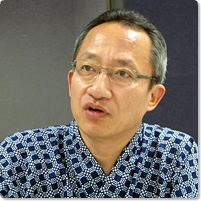
Kanjuro Kiritake III
Born in Osaka in 1953, the son of the Kanjuro Kiritake II, a Bunraku puppeteer who was designated a Living National Treasure by the Japanese government. His elder sister is the actress Kyoko Mitsubayashi. He became a puppetry trainee of the Bunraku Association in 1967. He studied under Minosuke Yoshida III and first performed on stage the following year. He performs both male and female roles, having learned tachiyaku male roles from his father and onnagata female roles from his the famous onnagata puppeteer Minosuke. In 200 he inherited his father’s name and became Kanjuro Kiritake III. In addition to performing, he conducts workshops, he teaches at the Nose Ningyo Jorori Rokkau-za theater in the Nose-cho district of Osaka and also produces new plays. He is the president in charge of copyrights for the NPO Ningyo Jorori Bunraku-za.
Interviewer: Kazumi Narabe
About Bunraku
Bunraku was born in the commercial city of Osaka as a form of ningyo joruri (music theater performed by puppets) of and for the common people. The roots of Bunraku go back to the famous joruri (musically accompanied storytelling) performer Gidayu Takemoto who founded the Takemoto-za theater in the mid-17thh century and later teamed with the joruri playwright Monzaemon Chikamatsu to create plays beginning with Shusse Kagekiyo (Kagekiyo Victorious) and followed by Sonezaki Shinju (Love Suicides at Sonezaki) and Meido no hikyaku (The Courier for Hell) that are still performed today as central works of the Bunraku repertoire. The plays of ningyo joruri (puppet joruri) all deal with themes of parent-child love, love between man and woman, conflicts of loyalty and duty and the trials and tribulations of life. The stories are recited by the tayu , who varies his voice to the roles of old and young, male and female characters. The tayu is accompanied by the 3-stringed futozao shamisen with its deep reverberating sound. This joruri is acted out by the 3-man-manipulated Bunraku puppet with movement so expressive that the puppet seems to come alive. The human dramas played out by the beautifully integrated 3-part performance of the tayu, shamisen and puppets seldom fails to win the hearts of the audience.
In its heydays from the 17th to 19th centuries, many different ningyo joruri theaters and performers competed for popularity, but the onset of Japan’s modernization and Westernization brought a decline in the popularity of the medium. By the beginning of the 20th century there was final only one theater still performing ningyo joruri, the Bunraku-za in Osaka. And from that time ningyo joruri came to be known as Bunraku. World War II hastened the decline of Bunraku as many of the more famous masters of the art died in the war and the Bunraku-za theater with its specialized facilities burned down in air raids. After that Bunraku lost its ability to compete against the new-age mass-entertainment media of film and television. To save Bunraku from extinction in this postwar crisis, the national government, the prefectural and municipal governments of Osaka and the national broadcasting company NHK joined together to provide support and launch the Bunraku Association in 1963. In 1972, the National Theater in Tokyo established a program to train young people aspiring to become Bunraku tayu, shamisen players and puppeteers, as part of larger program to preserve Japan’s traditional arts be fostering the next generation of performers. In the world of Bunraku, where advancement is based on talent and achievement rather than family lineage, 50% of today’s performers have come from this National Theater training program. In 1984, a new National Bunraku Theater was opened in Osaka to give the art a new center of operations. In 2003 UNESCO designated Bunraku an Intangible World Heritage. Today there are 25 tayu, 18 shamisen players and 37 puppeteers in the Ningyo Joruri Bunraku-za theater group.
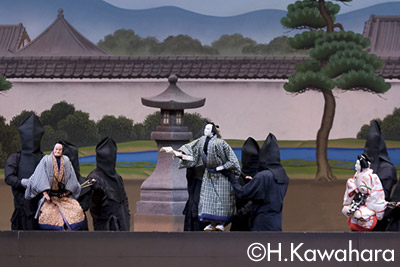
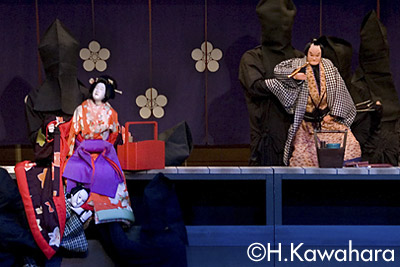
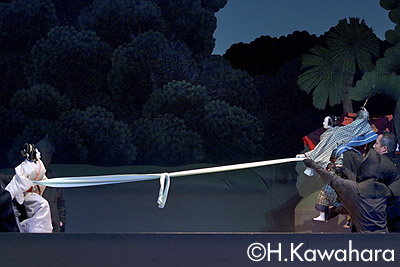
Sonezaki Shinju (The Love Suicides at Sonezaki)
© K. Kawahara
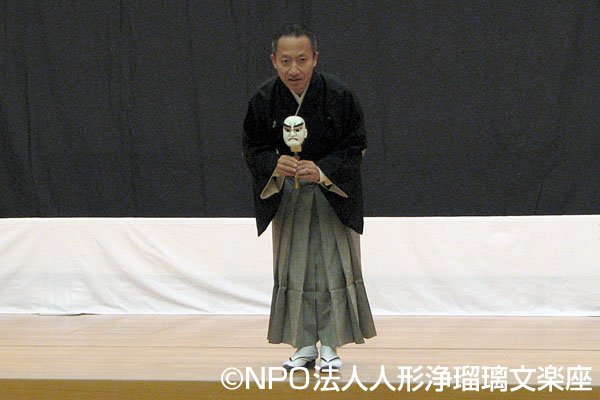
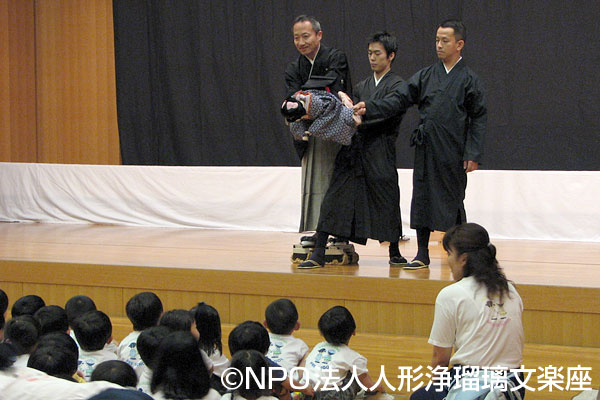
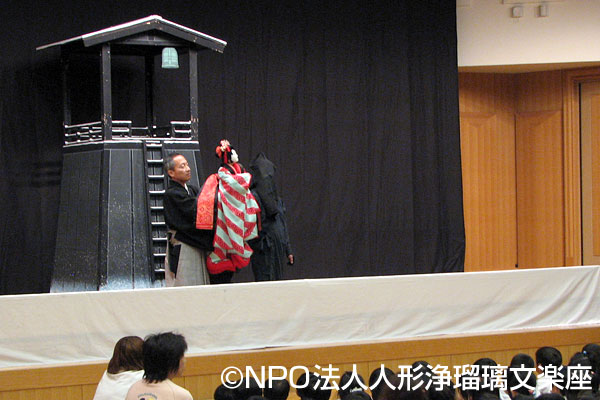
Outreach program in kindergarten
Photo: NPO Ningyo Joruri Bunraku-za

